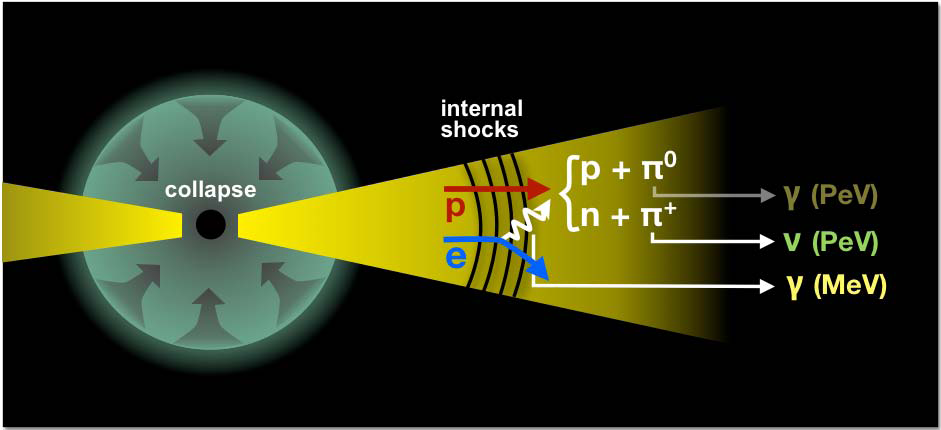
Although cosmic rays were discovered 100 years ago, their origin remains one of the most enduring mysteries in physics. Now, the IceCube Neutrino Observatory, a massive detector in Antarctica, is honing in on how the highest energy cosmic rays are produced.
Cosmic rays are electrically charged particles, such as protons, that strike Earth from all directions, with energies up to one hundred million times higher than those created in man-made accelerators. The intense conditions needed to generate such energetic particles have focused physicists' interest on two potential sources: the massive black holes at the centers of active galaxies, and the exploding fireballs observed by astronomers as gamma ray bursts (GRBs).

IceCube is using neutrinos, which are believed to accompany cosmic ray production, to explore these theories. In a paper published in the April 19 issue of the journal Nature (Volume 484, Number 7394), the IceCube collaboration describes a search for neutrinos emitted from 300 gamma ray bursts observed, most recently in coincidence with the SWIFT and Fermi satellites, between May 2008 and April 2010. Surprisingly, they found none - a result that contradicts 15 years of predictions and challenges one of the two leading theories for the origin of the highest energy cosmic rays.
"The result of this neutrino search is significant because for the first time we have an instrument with sufficient sensitivity to open a new window on cosmic ray production and the interior processes of GRBs," said IceCube spokesperson and University of Maryland physics professor Greg Sullivan. "The unexpected absence of neutrinos from GRBs has forced a re-evaluation of the theory for production of cosmic rays and neutrinos in a GRB fireball and possibly the theory that high-energy cosmic rays are generated in fireballs."
IceCube is a high-energy neutrino telescope at the geographical South Pole in Antarctica, operated by a collaboration of 250 physicists and engineers from the USA, Germany, Sweden, Belgium, Switzerland, Japan, Canada, New Zealand, Australia and Barbados. The IceCube Neutrino Observatory was built under a National Science Foundation (NSF) Major Research Equipment and Facilities Construction grant, with assistance from partner funding agencies around the world. The NSF Office of Polar Programs continues to support the project with a Maintenance and Operations grant. Construction was finished in December 2010.
The Inter-university Institute for High Energies, IIHE(ULB-VUB), in Brussels hosts one of the main IceCube analysis centers in Europe and the Brussels IceCube research team is, amongst other topics, heavily involved in the search for high-energy neutrinos related to Gamma Ray Bursts and Active Galactic Nuclei.The IceCube team at the IIHE consists of members from both the Université Libre de Bruxelles (ULB) and from the Vrije Universiteit Brussel (VUB) with professors K. Hanson and C. De Clercq as institutional leads, respectively, and dr. G. Kohnen of the University of Mons.
The IceCube research efforts in Brussels have been made possible thanks to the financial support of the Funds for Scientific Research FRS-FNRS and FWO-Vlaanderen, the FWO Odysseus program, the Belgian Federal Science Policy Office (Belspo) and the Flanders Institute to encourage scientific and technological research in industry (IWT).
"The analysis reflected in the current Nature article reports the results of a search for GRB neutrinos with the partially completed IceCube detector. The absence of an observed signal has severe consequences for the standard fireball scenario, which is the common basis for various theoretical models trying to describe cosmic ray and high-energy neutrino generation in these cataclysmic events," according to Nick van Eijndhoven, physics professor and leader of the GRB group at the Vrije Universiteit Brussel (VUB). "However, at the IIHE(ULB-VUB) in Brussels we are developing an alternative analysis method with which we will investigate the data of the completed IceCube observatory. With this new method we expect to increase the sensitivity for non-standard production mechanisms and hope to shed some light on this intriguing puzzle in the near future".
IceCube observes neutrinos by detecting the faint blue light produced in neutrino interactions in ice. Neutrinos are of a ghostly nature; they can easily travel through people, walls, or the planet Earth. To compensate for the antisocial nature of neutrinos and detect their rare interactions, IceCube is built on an enormous scale. One cubic kilometer of glacial ice, enough to fit the great pyramid of Giza 400 times, is instrumented with 5,160 optical sensors embedded up to 2.5 kilometers deep in the ice.
GRBs, the universe's most powerful explosions, are usually first observed by satellites using X-rays and/or gamma rays. GRBs are seen about once per day, and are so bright that they can be seen from half way across the visible Universe. The explosions usually last only a few seconds, and during this brief time they can outshine everything else in the universe.
"Although we have not discovered where cosmic rays come from, we have taken a major step towards ruling out one of the leading predictions," said IceCube principal investigator and University of Wisconsin - Madison physics professor Francis Halzen.
Improved theoretical understanding and more data from the compete IceCube detector will help scientists better understand the mystery of cosmic ray production. IceCube is currently collecting more data with the finalized, better calibrated, and better understood detector.
For more information about IceCube, visit www.icecube.wisc.edu.
IIHE Further IceCube information:
Catherine De Clercq, Vrije Universiteit Brussel (VUB)
Kael Hanson, Université Libre de Bruxelles (ULB)
Nick van Eijndhoven, Vrije Universiteit Brussel (VUB)
Inter-university Institute for High Energies IIHE(ULB-VUB)
Pleinlaan 2, B-1050 Brussel, Belgium
www.iihe.ac.be.
The Inter-university Institute for High Energies, IIHE(ULB-VUB), is specialized in (astro)particle physics research. The present research programme of the IIHE is performed at the IceCube neutrino observatory at the South Pole and at the accelerator complex at CERN.The IceCube research group of the IIHE performs studies related to neutrinos from Gamma Ray Bursts and Active Galactic Nuclei, Supernovae and Dark Matter in the Milky Way.
